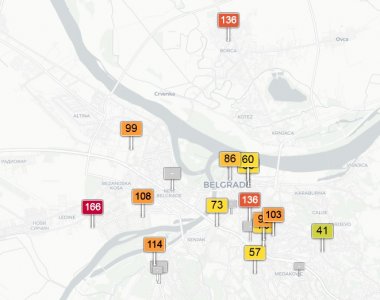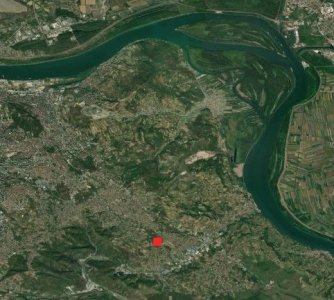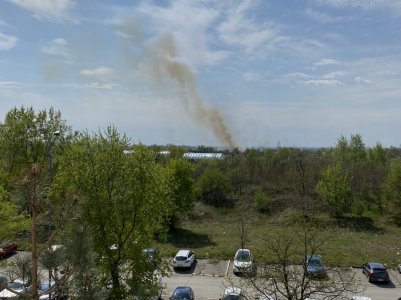Koristite zastareli preglednik. Možda se neće pravilno prikazivati ova ili druge veb stranice.
Trebalo bi da nadogradite ili koristite alternativni preglednik.
Trebalo bi da nadogradite ili koristite alternativni preglednik.
Zagađenje urbane sredine i kako ga se rešiti - izduvni gasovi, buka
- Začetnik teme Igor
- Datum pokretanja
astrodule
Professional
Užas. Znam da je vanredno stanje, ali upravo zato sada postoji toliko mnogo gradskih službi koje ne rade ništa i koje bi mogle ozbiljno da se pozabave ovim problemom od kojeg umire mnogo više ljudi nego od virusa.
To ljudi nikako da shvate.
To ljudi nikako da shvate.
Дошљак
Professional
- Učlanjen(a)
- 31.10.2014.
- Poruke
- 39.037
- Pohvaljen
- 69.458
Просто некоординација. Да има иоле памети, задње 4 године би се радило на подизању свих објеката јавних установа на већи еколошки ниво - гасификација где нема централног грејања, изолација и замена столарије, соларни панели на крововима + обавезна сепарација смећа за рециклажу.
MC_
Professional
- Učlanjen(a)
- 14.11.2017.
- Poruke
- 11.791
- Pohvaljen
- 12.086
Skrenuo bih paznju da je dok smo mi zatvoreni spaljivacka/vatrena aktivnost u Smederevu 6 X veca nego ranije.
Dokaz?
NASIN sajt za detekciju pozara i plamena.
https://firms.modaps.eosdis.nasa.gov/ma ... 2020-04-06

Svako prijateljstvo ima svoju cenu.
Dokaz?
NASIN sajt za detekciju pozara i plamena.
https://firms.modaps.eosdis.nasa.gov/ma ... 2020-04-06

Svako prijateljstvo ima svoju cenu.
Prilozi
astrodule
Professional
Lepo vreme, nema saobraćaja, a nismo "u zelenom".
Šta reći više?
Jedva čekam da prođe ovo oko Covid19, pa da nas nadležni još malo lažu oko zagađenja.
Šta reći više?
Jedva čekam da prođe ovo oko Covid19, pa da nas nadležni još malo lažu oko zagađenja.
dragan
Professional
Verovatno meri pivećan izvor toplote, a to je uvek pored fabričkih dimnjaka.[url=http://beobuild.rs/forum/viewtopic.php?p=724617#p724617:2dy2grko je napisao(la):MC_ » 06 Apr 2020 01:14 pm[/url]":2dy2grko]Dokaz? . . NASIN sajt za detekciju pozara i plamena.
https://firms.modaps.eosdis.nasa.gov/ma ... 2020-04-06
Identifikovali smo do sada mnogo različitih izvora zagađenja, sa veoma različitim uticajem na vazduh koji udišemo:
- Individualna ložišta
- Termoelektrane i Industrijska postrojenja
- Saobraćaj
- Deponije
- Paljenje rastinja
- Spaljivanje sekundarnih sirovina
- Duvanski dim
...
Ipak, i pored toliko različitosti, svi imaju dve zajedničke karakteristike. Osim ove štetne karakteristike da nas zagađuju, druga zajednička karakteristika je odnos države prema njima. Taj odnos je bolesno ignorantski.
- Individualna ložišta
- Termoelektrane i Industrijska postrojenja
- Saobraćaj
- Deponije
- Paljenje rastinja
- Spaljivanje sekundarnih sirovina
- Duvanski dim
...
Ipak, i pored toliko različitosti, svi imaju dve zajedničke karakteristike. Osim ove štetne karakteristike da nas zagađuju, druga zajednička karakteristika je odnos države prema njima. Taj odnos je bolesno ignorantski.
astrodule
Professional
19:20 Fontana - miris paljevine (recimo kao kada se pale kablovi, pa smrdi izolacija). Vetar duva zapadni. Ne bi me čudilo da je izvor temelj nikad izgrađenog muzeja pored SIV-a jer tamo često svašta spaljuju.
dragan
Professional
U odnosu na Fontanu SIV nije na zapadu odakle duva vetar. . . možda je sa Bežanijske kose.
astrodule
Professional
U pravu si. Moja greška. Vetar duva ka zapadu, znači istočni je u pitanju.
Na Tviteru neki prijavljuju smrad sa deponije, tako da je to možda u pitanju.
Na Tviteru neki prijavljuju smrad sa deponije, tako da je to možda u pitanju.
MC_
Professional
- Učlanjen(a)
- 14.11.2017.
- Poruke
- 11.791
- Pohvaljen
- 12.086
MC_
Professional
- Učlanjen(a)
- 14.11.2017.
- Poruke
- 11.791
- Pohvaljen
- 12.086
Oseca se kako nesto smrdi u vazduhu, neka paljevina opet.
Nasa slika i prilika, po rel toplom vremenu imamo ovakvo stanje:
Zagadjenje nije homogeno kao u januaru. Ono sto prema NASI-nom sajtu gori u Vinci nije dovoljno da zagadi ceo grad.

Pored Smedereva imamo opet i spaljivanje necega u Vinci.

"Koga briga", sto bi rekao zli antijunak iz crtanog filma "Noddy".
Nasa slika i prilika, po rel toplom vremenu imamo ovakvo stanje:
Zagadjenje nije homogeno kao u januaru. Ono sto prema NASI-nom sajtu gori u Vinci nije dovoljno da zagadi ceo grad.

Pored Smedereva imamo opet i spaljivanje necega u Vinci.

"Koga briga", sto bi rekao zli antijunak iz crtanog filma "Noddy".
Prilozi
10k
Higher intermediate
- Učlanjen(a)
- 25.02.2020.
- Poruke
- 505
- Pohvaljen
- 1.842
Juče je bilo paljenja u području izmedju blokova, savskog nasipa i Vinogradske ulice!
Mada nije bilo strašno kao što zna da bude!
Sumnjam da se odavde osetilo, ali eto rekoh da prijavim ovde, pošto nadležne i nadležno ministarstvo zabole ona stvar za to!
Mada nije bilo strašno kao što zna da bude!
Sumnjam da se odavde osetilo, ali eto rekoh da prijavim ovde, pošto nadležne i nadležno ministarstvo zabole ona stvar za to!
astrodule
Professional
Procedura i zakon su jasni.
Problem je što to ne sprovode.
Problem je što to ne sprovode.
Zvezdara64
Intermediate
- Učlanjen(a)
- 23.12.2013.
- Poruke
- 234
- Pohvaljen
- 350
World cities turn their streets over to walkers and cyclists
From Berlin to Bogotá there are new footpaths and bike lanes – but not in London
A growing number of cities around the world are temporarily reallocating road space from cars to people on foot and on cycles to keep key workers moving and residents in coronavirus lockdown healthy and active while socially distancing.
Limited urban park space and leisure trails are under increasing pressure, with many closed to prevent the spread of coronavirus, further limiting urban dwellers’ access to outdoor space. While traffic has dropped around the world, and with it nitrogen dioxide levels, there are widespread concerns over a rise in speeding drivers endangering those walking and cycling.
Evidence suggests air pollution, including from exhaust fumes, significantly harms the survival chances of those with Covid-19. With pedestrians crammed on to narrow pavements, and acres of empty asphalt on roads, lower speed limits, filtering residential streets to prevent rat-running, introducing emergency cycleways and expanding footpaths are among potential solutions.
Tabitha Combs, a lecturer at the University of North Carolina, is collating examples from around the world, adding to growing calls for more such measures.
“No matter where a city is on the spectrum of supporting walking and bicycling, there are actions that are within their reach, and precedents of those actions being implemented in peer cities around the globe,” she says.
In Philadelphia officials closed 4.7 miles of Martin Luther King Jr Drive, a wide riverside boulevard, to motor traffic on 20 March following an 1,100-strong petition, as leisure trails became overwhelmed by residents seeking their daily exercise.
Minneapolis has closed part of its riverfront parkways to motor vehicles. Denver has introduced pop-up cycling and walking lanes on 16th and 11th Avenues and roads around Sloan Lake to help people socially distance while exercising. On Thursday, Oakland officials said they were planning to close 74 miles of roads – 10% of the city’s total – to motor vehicles.
In Canada, Vancouver’s park board announced that Stanley Park is now cycling and walking only, as well as the linked eastbound lane of Beach Avenue, to relieve congestion and stop visitors arriving by car and parking dangerously, amid a 40% increase in park users. In Winnipeg, four streets are restricted to cycling and walking from 8am-8pm daily, and in Calgary traffic lanes have been reallocated to cycling.
Like many cities, Budapest has seen a drop in bus use by almost 90%, with a 50% decrease in road traffic. City officials have now planned a cycling network on main roads.
Sydney, Perth and Adelaide in Australia, Chapel Hill in the US and Calgary in Canada are among the cities that have made pedestrian crossings automatic in some districts so that people do not have to press a button.
In Berlin, a slew of streets have new, wide bike lanes in place of some motor vehicle lanes. Bogotá has ambitiously replaced 35km of traffic lanes with new emergency bike lanes using temporary cones, mirroring the Colombian capital’s TransMilenio bus rapid transit network, an alternative to people using public transport. Workers adjust the lane width depending on usage.
In late March the bicycle mayor of Mexico City proposed 130km of temporary bike lanes. In the meantime, a 1.7km temporary lane, running 8am-7pm, has been installed on a major thoroughfare.
In the UK, however, it is a very different picture. In London, where traffic has dropped by 63% on main roads, walking and cycling commissioner Will Norman says emergency bike routes on the city’s arterial roads would not protect cyclists without complex junction improvements, which would require construction workers to travel during lockdown.
Cycling UK’s policy director, Roger Geffen, has suggested junctions could be redesigned while roads are quieter, saying temporary cycling infrastructure “provides a good experience to new commuters, while claiming that kerb space when it’s not under pressure and not as disruptive to make changes”.
Hackney council in east London is the first UK local authority openly planning to temporarily “filter” its streets, using bollards and planters to prevent rat-running while maintaining access for emergency vehicles and residents. Councillor Jon Burke says it will decide which streets to filter on 20 April, before starting work.
Burke told the Guardian pedestrians stepping into the road to socially distance from one another are put at risk by speeding drivers, whose number appears to be increasing during the lockdown. He says construction workers can operate while socially distancing, and it is one sector with excess capacity during the pandemic.
“We are running around making sure vulnerable people have enough food but we aren’t doing something about the 40,000 people that are dying each year because of air pollution,” he says. “We haven’t got weeks to deliver it, we need to deliver it now, because this crisis is happening now.”
Dr Rachel Aldred, reader in transport at the University of Westminster, says the UK could learn from other countries. “It feels like they are treating [cycling] like a proper mode of transport and we are just fumbling around. There’s no guidance from the government … I think if they can manage it in Bogotá, which is a very complicated megacity with a lot of issues, you could imagine London doing similar,” she said, adding that much of the planning could be done remotely.
Transport engineer Brian Deegan says 20mph streets, bikes for key workers, and “core corridor” emergency cycle routes would help more essential staff cycle, while removing guard rails on pavements and extending pedestrian space using traffic cones would help those on foot. The London Cycling Campaign has also come up with short, medium and long-term proposals to improve active travel in the capital during the crisis.
izvor: The Guardian https://www.theguardian.com/world/2020/ ... aincontent
Zvezdara64
Intermediate
- Učlanjen(a)
- 23.12.2013.
- Poruke
- 234
- Pohvaljen
- 350
[url=http://beobuild.rs/forum/viewtopic.php?p=726554#p726554:1tsent12 je napisao(la):Zuma » Sat Apr 11, 2020 12:08 pm[/url]":1tsent12]Even before the new Harvard study, scientists were convinced that air pollution was likely worsening COVID-19’s impact, in addition to the wide-ranging health damage it causes on its own. A 2003 study of the outbreak of SARS, the closest relative of the new coronavirus, found that death rates in China’s most polluted areas were twice as high as in the least polluted ones.
“You could bet a fiver that London and other more polluted places will have higher mortality rates [from the virus], because there’ll be more people with underlying issues,” Birkett said. Scientists also believe viruses may bond with pollution particles, enabling them to remain in the air longer and helping them make their way into the body.
The flip side is that even temporarily cleaner air can help “flatten the curve” of the pandemic, easing the burden on health care systems by reducing the number of people who experience severe COVID-19 symptoms, said Christopher Carlsten, head of respiratory medicine at the University of British Columbia’s School of Population and Public Health, in Vancouver.
Cleaner pandemic skies should also reduce other pressures on hospitals struggling with COVID-19 cases, Carlsten said. In addition to the cumulative effects of breathing dirty air for years, a large body of evidence shows that short-term changes in air quality have an immediate impact on heart attacks, strokes, and emergency room visits. All increase when pollution spikes.
In China, the drops in pollution resulting from coronavirus shutdowns likely saved between 53,000 and 77,000 lives—many times more than the direct toll of the virus—according to calculations done by Marshall Burke, an Earth system scientist at Stanford University. That might sound surprising, but it shouldn’t be, he said, given that air pollution causes more than 1.2 million annual deaths in China. Indeed, a 2016 study found that China’s aggressive measures to clean the air in and around Beijing for the 2008 Olympics had led to a temporary 8 percent drop in the overall death rate.
https://www.nationalgeographic.com/scie ... n-the-sky/
Preneto sa teme Epidemija CoViD-19. Hvala @Zuma!
MC_
Professional
- Učlanjen(a)
- 14.11.2017.
- Poruke
- 11.791
- Pohvaljen
- 12.086
U Beogradu mase zele da voze kola.
To sa biciklima ovde nece proci.
U Omoljici i Smederevu i dalje purnja.
https://firms.modaps.eosdis.nasa.gov/ma ... 2020-04-11
To sa biciklima ovde nece proci.
U Omoljici i Smederevu i dalje purnja.
https://firms.modaps.eosdis.nasa.gov/ma ... 2020-04-11
Zvezdara64
Intermediate
- Učlanjen(a)
- 23.12.2013.
- Poruke
- 234
- Pohvaljen
- 350
Mozda prodje i kod nas, jednog dana.. 
tzoran1
Advanced
koji djavo spaljuju u Omoljici?
astrodule
Professional
Prijavio sam Beokomu https://twitter.com/astrodule/status/12 ... 8788044802
Preporučite:





